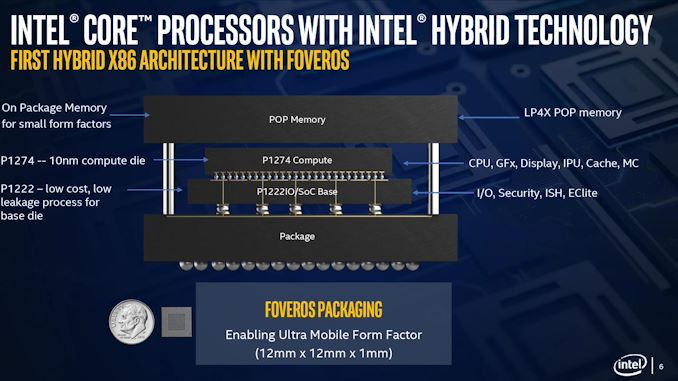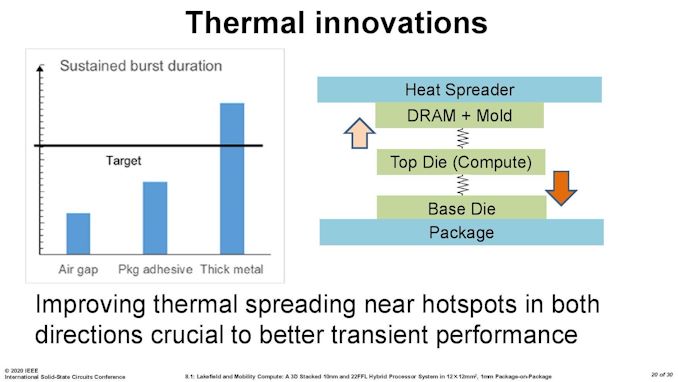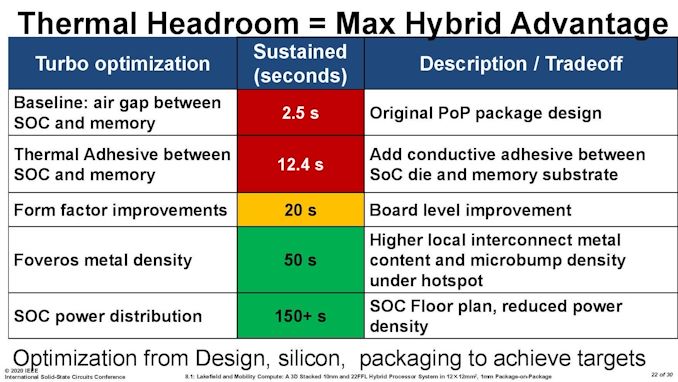The Intel Lakefield Deep Dive: Everything To Know About the First x86 Hybrid CPU
by Dr. Ian Cutress on July 2, 2020 9:00 AM ESTThermal Management on Stacked Silicon
With a standard processor design, there is a single piece of silicon doing all the work and generating the heat – it’s bonded to the package (which doesn’t do any work) and then depending on the implementation, there’s some adhesive to either a cooler or a headspreader then a cooler. When moving to a stacked chiplet design, it gets a bit more complicated.
Having two bits of silicon that ‘do work’, even if one is the heavy compute die and the other is an active interposer taking care of USB and audio and things, does mean that there’s a thermal gradient between the silicon, and depending on the bonding, potential for thermal hotspots and build-up. Lakefield makes it even more complex, by having an additional DRAM package placed on top but not directly bonded.
We can take each of these issues independently. For the case of die-on-die interaction, there is a lot of research going into this area. Discussions and development about fluidic channels between two hot silicon dies have been going on for a decade or longer in academia, and Intel has mentioned it a number of times, especially when relating to a potential solution of its new die-to-die stacking technology.
They key here is hot dies, with thermal hotspots. As with a standard silicon design, ideally it is best to keep two high-powered areas separate, as it gives a number of benefits with power delivery, cooling, and signal integrity. With a stacked die, it is best to not have hotspots directly on top of each other, for similar reasons. Despite Intel using its leading edge 10+ process node for the compute die, the base die is using 22FFL, which is Intel’s low power implementation of its 14nm process. Not only that, but the base die is only dealing with IO, such as USB and PCIe 3.0, which is essentially fixed bandwidth and energy costs. What we have here is a high-powered die on top of a low powered die, and as such thermal issues between the two silicon die, especially in a low TDP device like Lakefield (7W TDP), are not an issue.
What is an issue is how the compute die gets rid of the heat. On the bottom it can do convection by being bonded to more silicon, but the top is ultimately blocked by that DRAM die. As you can see in the image above, there’s a big air gap between the two.
As part of the Lakefield design, Intel had to add in a number of design changes in order to make the thermals work. A lot of work can be done with the silicon design itself, such as matching up hotspots in the right area, using suitable thickness of metals in various layers, and rearranging the floorplan to reduce localized power density. Ultimately both increasing the thermal mass and the potential dissipation becomes high priorities.
Lakefield CPUs have a sustained power limit of 7 watts – this is defined in the specifications. Intel also has another limit, known as the turbo power limit. At Intel’s Architecture Day, the company stated that the turbo power limit was 27 watts, however in the recent product briefing, we were told is set at 9.5 W. Historically Intel will let its OEM partners (Samsung, Lenovo, Microsoft) choose its own values for these based on how well the design implements its cooling – passive vs active and heatsink mass and things like this. Intel also has another factor of turbo time, essentially a measure of how long the turbo power can be sustained for.
When we initially asked Intel for this value, they refused to tell us, stating that it is proprietary information. After I asked again after a group call on the product, I got the same answer, despite the fact that I informed the Lakefield team that Intel has historically given this information out. Later on, I found out through my European peers that in a separate briefing, they gave the value of 28 seconds, to which Intel emailed me this several hours afterwards. This value can also be set by OEMs.
Then I subsequently found one of Intel’s ISSCC slides.
This slide shows that a basic implementation would only allow sustained power for 2.5 seconds. Adding in an adhesive between the top die and the DRAM moves up to 12.4 seconds, and then improving the system cooling goes up to 20 seconds. The rest of the improvements work below the compute die: a sizeable improvement comes from increasing the die-to-die metal density, and then an optimized power floor plan which in total gives sustained power support for 150+ seconds.













221 Comments
View All Comments
Santoval - Saturday, July 4, 2020 - link
AVX2/512 is not the only bit that differentiates the Core series from Atom. If you only care about floating point performance then yes, that's their primary difference. AVX has nothing to do with integer code though.ProDigit - Friday, July 3, 2020 - link
Not a single program, other than benchmarks use it.Very few use avx 256 even...
I wonder why anyone would need it on a laptop, especially considering it's a server feat.
Meteor2 - Friday, July 3, 2020 - link
Not photo and video editing software?lefty2 - Friday, July 3, 2020 - link
Tremont doesn't support any version of AVX. So, that would cause a huge swath of software to operate very slow. AVX is used a lot more universally than you think - practically all games use it. All multimedia applications, photo editing software, etc, etc.dotjaz - Saturday, July 4, 2020 - link
Wrong, AVX2 is quite universal on any multimedia tasks. AVX512 is pointless.Samus - Saturday, July 4, 2020 - link
Clearly a first-gen product. Give it time.For my sake I hope this isn't a dud because Intel clearly invested billions into the thing and I own a lot of Intel stock lol.
neogodless - Thursday, July 2, 2020 - link
Why not rename them Core Hybrid Intel Processors? Makes a great initialism!eastcoast_pete - Thursday, July 2, 2020 - link
With this decision (no AVX), they should call it a "Crybid". Those relaxed marijuana laws in CA sure have unexpected repercussions, but answer the question "what were they smoking?".YB1064 - Thursday, July 2, 2020 - link
"The bottom chiplet contains the ‘peripheral’ components that are not as performance related, such as security controller, USB ports, and PCIe lanes. This is built on Intel’s cheaper 22nm manufacturing node."Surely they are not going to go back to 22nm? The packaging engineering is interesting enough, but there seems to be no fundamental architecture improvements. I see Zen-xx crushing this straight out the gate. Definitely not adaptable for desktop use.
III-V - Thursday, July 2, 2020 - link
>I see Zen-xx crushing this straight out the gate. Definitely not adaptable for desktop use.This is a 7W processor, dumbass.